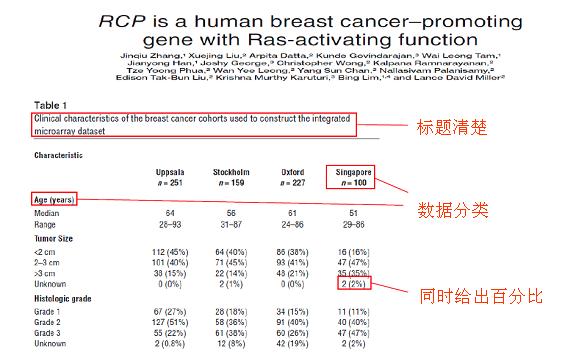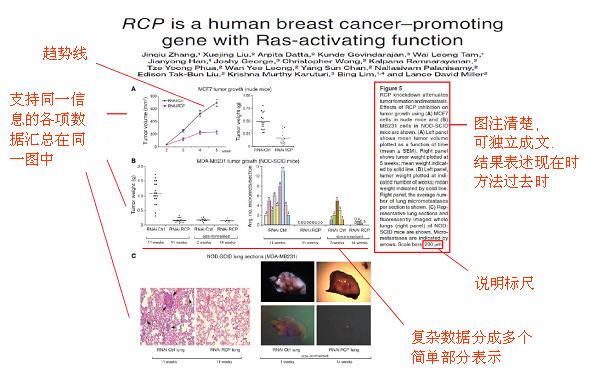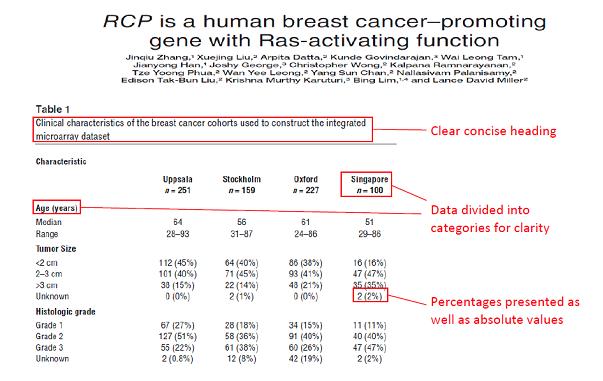博文
图表:一图值千字 Display items
||

在“摘要”一贴的注意事项中我提到不少读者只读摘要,所以摘要必须能独立成文,并能说明所有主要结果及其意义。有的读者会随后再看一下图表来核实一下摘要中提到的结果,但仍然不读全文。所以,跟摘要一样,论文的图表(外加其标注)也必须能独立成文,不用读正文就能看懂。
图 表用于形象地表示正文所述结果。简而言之,他们是表达结果最有效的方式。好的图表可以把获得的结果迅速、准确地传达给读者(远比读正文为快)。对于研究人 员来说,一方面他们所处的领域飞速进展,另一方面他们又缺乏足够的时间追踪研究进展,因此,如果你能迅速地把自己的研究结果传递给他们,他们自然感激不 尽。期刊编辑和审稿人当然也喜欢简洁明了的论文。所以制作高质量的图表来清楚传达研究结果还是很有必要的。
和其他部分一样,制作图表也有 一些“规则”。首先要了解目标期刊允许多少图表,不要超过这个限制。如果限定的图表数目不足以表达你的结果,可以把有些放在“补充信息 ”(Supplementary Information)部分,或者在正文中叙述并加个说明“(data not shown)”。不过,只有不重要的附属性结果才能这样叙述,而那些支持你假设的结果则必须展现出来。如果你的首选期刊不足以展现你的所有重要数据,你可 能需要考虑换个期刊。反之,如果期刊允许的图表数目超过你的需要,也不要加上多余或不必要的图表来凑数。每个图表必须要有明确、必要的目的。
其 次,图表中的数据要易于解读。考虑好让每个图表显示多少数据,以及数据如何组织来传递重要信息。所以,与其把各种参数或治疗方法都合并在一个图中,不如考 虑分别用一个简单子图表示然后拼成一个组图。图的坐标、表的行列、以及示意图的各部分都要标记清楚。如有趋势线、标尺和统计检验结果,均应予以标明;比如 用星号表示显著性,或不同的符号来表示不同的显著性水准。对于大样本,除了报告绝对数值之外还要有变化或差异的百分比。
第三,图表的标注 也应该独立成文,并且无需阅读全文就能完全理解。因此,缩写要么不用,要么先定义后才用,同时应该避免使用技术术语。标注应清楚说明做了什么、观察到了什 么;也应简述使用了什么统计检验,给出P值,并对所用的符号进行定义。除了其中描述方法的语句,标注和图表标题都应采用现在时。比如,应该 写:“Western blot showing an increase in the levels of p53 after…”而不是“Western blotting showed that the levels of p53 increased after…”。
最后,与“结果“部分的注意现项一样,图表和正文之间不应有重复叙述。所以,容易用文字简要描述的就不要用图表,而且图 表之间也不应有所重复,例如,图中已有的信息就不要又用表再显示一次。图表和标注不要嵌在正文中间。出版单位会把你的正文和图表合并成一个目标杂志特有格 式的“校样”。他们通常要求作者提供单独的图表文件(偶尔可以放在稿件末尾)和单独的正文文件(其中包含图表标注的列表,通常在”参考文献”之后)。参照 目标期刊的《稿约》以确定其具体要求。
先制作清楚、高质量的图表,随后就可以轻易地撰写“结果”部分。图表可以按逻辑排列组合来一步步推进你的论 证,或巩固你的假设。给每个主要结果分配一个图表和一个小节;小节的标题应和相应的标注相似;小节内的正文简要叙述其相应图表内含结果,其中统计分析结果 要叙述完整,需要展示更多细节时告知读者参见图表。
实例

表格最适合用很少的叙述展现大量数据。上表节选自《The Journal of Clinical Investigation》上的一篇论文(doi:10.1172/JCI37622; 经同意转载)。表中数据非常清楚简练,如果用正文叙述这些数据需要大量文字,用表格则大大节省了文字。正文中只需提一下“患者和肿瘤样本的临床特征见表1”即可。下图来自同一论文,其中包括了本文提及的优秀图表的多项要素,具体请见下面的清单。

清单
1. 图表标注要“独立成文”。
2. 遵守图表数目限制。
3. 图表之间以及图表和正文之间均无重复叙述。
4. 各个参数的数据分别用组图中的一个子图表示。
5. 标出标尺、趋势线和标记;显示统计检验结果。
6. 符号和缩写要么不用,要么先定义再用。
7. 对于大样本,给出绝对数和变化/差异的百分比。
8. 图放在单独的文件中或放在稿件末尾;不要嵌在正文中间。
9. 参照《稿约》确定图表格式、大小、颜色、数目和其他要求。
英文原文
Display items: a picture tells a thousand words
In the chapter on abstracts I mentioned that many readers will only read the abstract of your paper, and so the abstract needed to be self-contained, describing all of the important findings and their significance. Some readers will go further than just the abstract and look at the display items to validate the findings described in the abstract, but still not read the entire paper. Thus, like the abstract, the display items in your paper (along with their associated legends) need to be able to stand alone and be understood without the need to refer to the text of the paper.
Display items include figures and tables, which are essentially graphical representations of the results described in the text. Simply put, they are the most effective and efficient way to present your results. With good figures and tables you will be able to impart to the reader exactly what you found in your study in a relatively short period of time (that is, much faster than it would take the reader to read the entire paper). Researchers in rapidly moving fields or with limited time to keep up to date with advances in their field will appreciate the rapidity with which they can be informed of your findings; journals editors and peer reviewers will appreciate the clarity. Therefore, it is worthwhile devoting some thought and attention to developing good quality figures and tables that clearly convey your results.
As with the other sections of scientific manuscripts, there are certain ‘rules’ that should be followed when generating display items. First, if you have a target journal in mind already, consider how many display items they allow and ensure that you do not exceed that limit. If you have more results to describe than can be simply shown in the allowable number of display items, some may need to be included in a Supplementary Information section, or described in the text with the statement “(data not shown)”. However, only the least important or peripheral findings should be described in this way, and all findings that support your hypothesis need to be shown. Thus, you may need to consider an alternative journal if your first choice will not allow you to present all of your important data. By contrast, if a journal allows more display items than is necessary to show your findings, do not add redundant or unnecessary display items simply because you can. All display items must have a clear and necessary purpose.
Second, the data shown in figures and tables needs to be easy to interpret. Consider how much data you wish to show in a given display item and how it can be organized to convey the important message. Therefore, rather than combining multiple parameters or treatments into a single graphic, consider splitting the data across multiple simpler graphics that can be grouped together in a single figure. Remember to clearly label any graph axes, table columns and rows, and components of diagrams if appropriate. Trendlines, scale bars and the results of any statistical tests should be also shown, where relevant, for example by using an asterisk to indicate significance, or a variety of symbols to indicate different levels of significance. With large samples, report the % change or % difference as well as absolute values.
Third, the legends accompanying display items need to be able to stand alone such that the display items are entirely understandable without the need to read the entire manuscript. That means abbreviations should not be used or need to be defined, and technical terms should be avoided. It should be clear exactly what was done and what was seen. Statistical tests should be briefly described in the legends, with p values given and any symbols used defined. Legends, including their headings, should be written in the present tense with the exception of any methods described within them. For example, use “Western blot showing an increase in the levels of p53 after…” rather than “Western blotting showed that the levels of p53 increased after…”.
Finally, as mentioned in the chapter on writing the results section, there should be no redundancies between the display items and the text. Therefore, do not produce a display item to show information that can easily and briefly be stated in the text, and do not duplicate information among tables and figures, for example, by making a table to show the same information already conveyed in a figure. Do not embed figures and their legends within the text of the manuscript you plan to submit. The publisher will put your text and display items into a template ‘proof’ that will be specific to the target journal. What they usually require from authors is a separate file containing display items (occasionally these can be placed at the end of a manuscript files) and a text file that includes figure and table legends listed together at the end (usually following the references). Check the instructions for authors of your intended target journal for their specific requirements.
By preparing good quality, clear display items before writing the results section, this section will practically write itself. The display items can be grouped in a logical order that progresses your argument or progressively strengthens your hypothesis. With one subsection and one display item for each of the major findings, the subsection headings will be similar to the relevant legend headings, and the text in each subsection will provide a brief description of the findings shown in each display item, complete with the results of statistical analyses, with the reader being referred to the display items for more detail.
Examples

Tables are a great way to present large amounts of necessary data with minimal description required. The table shown above is a truncated version of a table in a paper published in The Journal of Clinical Investigation (doi:10.1172/JCI37622; reproduced with permission). The data presented clearly and economically in this table would have required a considerable amount of word space to describe in the text, but the use of a table makes the information available without the need for a wordy description. All that was required to describe this in the main text was the following statement: “Clinical characteristics of all patients and tumor samples are summarized in Table 1”. The figure below, taken from the same paper, contains many of the elements of a successful display item described in this chapter and listed in the checklist below.

Checklist
1. ‘Stand alone’ legends
2. Comply with the allowable number of display items
3. Avoid redundancy among display items or between display items and text
4. Divide data showing different effects or parameters among different panels within the same display item
5. Use scale bars, trend lines and clear labels, and show the results of statistical tests
6. Avoid or define all symbols and abbreviations
7. With large samples, show % changes/differences as well as absolute values
8. Submit figures in a separate file or at the end of the manuscript file rather than embedded in the main text
9. Check the instructions for authors for any specific requirements regarding format, size, color, number of items and any other parameters
Dr Daniel McGowan
分子神经学博士
理文编辑学术总监
https://blog.sciencenet.cn/blog-288924-581328.html
上一篇:Respectively
下一篇:逗号、连字符和“which”